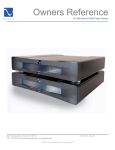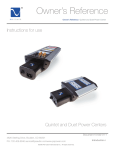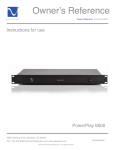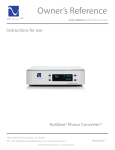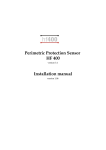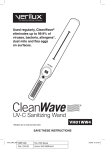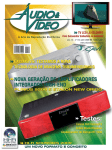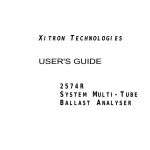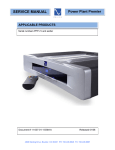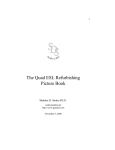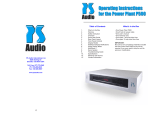Download PS Audio Power Plant Premier
Transcript
E Q U I P M E N T R E P O RT PS Audio Power Plant Premier ROBERT DEUTSCH DESCRIPTION AC regenerator. Nominal input voltage: 105–135VA US, 215–245VAC Europe/Asia. Maximum continuous load: 1200VA US, 1500VA Europe/Asia. Dynamic power delivery: 0.5s, >3600VA US, 5000VA Europe/Asia. Voltage regulation: ±0.5V US, 1VAC Europe/Asia. Output distortion, input 220–240VAC: 1200VA resistive load <0.9%. Output distortion, 230V: 240VAC, 1200VA reactive load <0.9%. Output distortion, input 110–130VAC: 1200VA resistive load, <0.5%. Output distortion, input 110–130VAC: 1200VA reactive load, <0.5%. Output impedance: <0.015 ohm. Noise reduction (all zones): 100kHz–2MHz, >80dB. Efficiency at 1200VA: resistive load, >80%; reactive load, >85%. Input frequency: 45–65Hz. Undervoltage limit: 90VAC US, 175VAC Europe/Asia. Overvoltage limit: 145VAC US, 275VAC Europe/ Asia. Protection modes: L-N, L-G, N-G. Energy dissipation: 2160J US, 2142J Europe/Asia. Peak current surge: 144,000A US, 84,000A Europe/ Asia. Maximum voltage surge: 6kV. Clamp level: 330V US, 800V Europe/ Asia. Telco protection: 320J, 395V. Coax insertion loss: <1dB. DC trigger configuration: tip positive. DC trigger voltage: 5–15V DC. DIMENSIONS 17" (435mm) W by 4" (100mm) H by 16.5" (425mm) D. Weight: 35 lbs (15.9kg). SERIAL NUMBER OF UNIT REVIEWED PPP-BO-7K0226. PRICE $2195. Approximate number of dealers: 147. MANUFACTURER PS Audio, 4826 Sterling Drive, Boulder, CO 80301. Tel: (720) 406-8946. Fax: (720) 406-8967. Web: www.psaudio.com. AC REGENERATOR PS Audio Power Plant Premier D etermining whether an idea is brilliant or off the wall is often a matter of perspective—and of looking at the results that follow from the idea. Take the notion of AC regeneration. AC is what comes from the wall socket, courtesy a network of power-generation plants, and it’s specified as having a certain voltage and frequency, with the amount of current limited by fuses or circuit breakers in the electrical panel of the house or apartment. Audio components— other than those powered by batteries—are designed to convert this alternating current (AC) to direct current (DC), then produce variable AC that drives the speakers to produce a facsimile of that signal. In short, AC provides the raw material used by audio components to do their job. Designers of audio components assume that the AC power source will have certain standardized characteristics (in North America, a 120V sinewave at 60Hz), and configure their prototypes’ internal power supplies with this in mind. These supplies are usually designed to filter out unwanted high-frequency distortion components that may be present in the AC power source. A separate AC line from the electrical panel, dedicated to serve only the audio system, is considered a good thing, providing a degree of isolation from household appliances and lights that can interfere with the purity of the AC power. For decades now, devices have been sold that are claimed to purify or “condition” AC, filtering out potential interference-causing parts of the AC waveform and thus easing the work of the audio components’ power supplies. Many audiophiles have found these devices helpful to the sound; others have rejected them because of what they felt were undesirable audible side effects, such as an obscuring of detail or a reduction in dynamic range, and because tests have often shown that their measurable effect on the AC waveform was minimal. Power to the people Enter the PS Audio Power Plant, originally introduced in 1997 as the model P300. Paul McGowan, the P of PS Audio (the S, Stan Warren, left the audio business some www.Stereophile.com, February 2009 www.fantamag.com & www.storemags.com 111 time ago), has argued that the best way to get rid of undesirable components of the AC is not to try to filter them out, but to “regenerate” the AC supply altogether with a power amplifier that outputs pure 120V at 60Hz. It’s like having your own power plant in the home—hence the name. (To carry the analogy further, perhaps the best thing would be to have your own power generator, fueled by gas or coal. Then you’d really be free of the vagaries of the electrical power grid.) The output of a PS Audio Power Plant is regulated 120V AC at 60Hz (50Hz in Europe) with low distortion, the maximum power output depending on the model (300W for the P300). I reviewed the P300 in the December 1999 Stereophile (Vol.22 No.12); John Atkinson’s Follow-Up appeared the following May. My conclusion, with which JA concurred, was that the P300 worked as claimed. It wasn’t just a matter of less noise, as expected, but also a generally smoother, more relaxed sound, with such goodies craved by audiophiles as “blacker blacks,” and no loss of resolution or impairment of dynamic range. The P300 and its higher-powered variants have been extraordinarily successful, selling lots of units, winning numerous awards from audio magazines, and finding homes in the reviewers’ systems—including mine and JA’s. In the February 2006 issue (Vol.29 No.2) I reviewed the P500, noting its improvements over the P300. Like any audio component, the P300 had its limitations. The first was of power output: 300W may be fine for source components and preamps, but it’s not enough for any but low-powered amplifiers. The higher-output P500 produced 500W—better, but still not enough for the big power amps—and if you went for the top-of-the line P1200 (1200W output), you had a 150-lb component to contend with—and a corresponding increase in your electricity bill. There was also the matter of heat: the P300 ran hot when working hard, and its cooling fan was noisy. The P300 had only four outputs, which meant having to use a power bar in complex systems—not an ideal solution. Over the years, the design of the Power Plant evolved, with new features such as MultiWave (an alternative to the standard AC sinewave, with a waveform that’s supposed to make components’ power supplies work more efficiently) and CleanWave (an AC power equivalent of variable-frequency signal-degaussing devices). And, to respond to the needs 112 Five pairs of isolated AC outlets, 1500W of regenerated power. of audiophiles not yet ready to plunge into the world of power regeneration, PS Audio continued work on passive devices, such as the balun-based Ultimate Outlet (which I reviewed in December 1991, Vol.24 No.12), and the ingenious Noise Harvester, which shunts some of the power line’s high-frequency noise to an LED, effectively transforming electrical noise into light. (I use Noise Harvesters in my home-theater system, to good effect.) Premier Primer Now we have the Power Plant Premier ($2195), which PS Audio calls “the world’s first and only low distortion, amplifier. What’s special about it is a new tracking power supply designed by Bob Stadtherr, PS Audio’s head of engineering, for which the company has received a patent. According to Paul McGowan, the concept of the tracking power-supply design is “elegantly simple, and its execution is breathtakingly complex to make it work.” Starting with the new higher-efficiency amplifier design, the slim, stylish chassis of the Premier (said to be based on the BMW automobile) includes every bit of AC-related technology that PS Audio has learned in the past decade. There is sophisticated spike and surge protection. THE BEST WAY TO GET RID OF UNDESIRABLE COMPONENTS OF THE AC IS NOT TO FILTER THEM OUT, BUT TO “REGENERATE” THE AC SUPPLY. high efficiency AC power regenerator.” The key part of this claim is “high efficiency.” Earlier Power Plants consisted of a class-AB stereo amplifier with an efficiency of about 50%—which meant that they had to be very heavy if they were to output substantial amounts of power, hence current. The Premier’s maximum output is 1500W; a Power Plant of the previous design that produced this much output would weigh about 200 lbs. Instead, it’s a far more manageable 35 lbs. This is the result of a new amplifier design that’s 85% efficient—but is not, as might be expected, class-D, which PS Audio determined would produce too much noise for this application. Instead, it’s a development of the usual class-AB (Other protective devices typically include protection against brief high-voltage spikes, but don’t protect against more moderate surges that last longer and are potentially more damaging.) Voltage is regulated between 105V and 135V: whatever the voltage of the incoming AC, the output is 120V. And with up to 1500W on tap, there isn’t the current limiting that was characteristic of the original P300. Noise between 100kHz and 2MHz is reduced in all modes by more than 80dB. Like earlier Power Plants, the Premier has a fan, but the amp runs far more coolly than its predecessors; the fan isn’t expected to come on unless there’s considerable sustained current draw. In my situation, using the highly sensitive www.Stereophile.com, February 2009 www.fantamag.com & www.storemags.com PS AUDIO POWER PLANT PREMIER Avantgarde Uno Nano speakers, the fan stayed off most of the time; and when it was on, it was very quiet. One of the most impressive things about the Premier is its ability to reduce harmonic distortion in the incoming AC. At various consumer-electronics shows, PS Audio had earlier demonstrated this effect of the Power Plant design by using a Fluke power-quality analyzer. With the Premier, they’ve included a built-in harmonic-distortion meter; you can switch the front-panel display to show the THD of the incoming AC and of the output. In my situation, the input THD was in the region of 3–4%, the output around 0.3%. The Premier allows a choice between sinewave and MultiWave. However, it’s missing some options available in earlier Power Plant models: variable-frequency sinewave and a variety of MultiWave settings. I guess PS Audio got tired of people calling customer service and asking, “Is MultiWave 1 better than MultiWave 2, or should I set it at AutoWave?” The MultiWave pattern included in the Premier is equivalent to what was called TubeWave in the last generation of Power Plants. However, not all audio electronics respond well to MultiWave, which shouldn’t be used with anything that has an AC motor, and not if, as the Premier’s owner’s manual puts it, you hear “funny noises” coming from the equipment. For consistency in reviewing digital source components, preamplifiers, and power amplifiers, I’ve settled on using the sinewave setting, which is the same as normal AC except cleaner, and avoids the possibility of any negative interaction of MultiWave with audio equipment’s power supplies. The Premier also has an ingenious way of dealing with the turn-on power surges of very large power amplifiers: If the current needed exceeds the Premier’s regenerated power capabilities, the Premier connects the amplifier directly to the wall AC until the temporary need for high power has abated. For those with amplifiers whose long-term thirst for power is unquenchable (or who can’t afford the Premier), PS Audio offers the Duet and Quintet THE RESULT, ACCORDING TO PS AUDIO IS “AN ISOLATION AND CLEANING NETWORK THAT IS BOTH NON-INTRUSIVE AND AN EXCELLENT PERFORMER.” The Premier has five pairs of isolated AC outlets, all functionally identical, and distributed among three switchable Zones. Again in contrast to some earlier Power Plant models, the Premier has no outlets with only passive filtering. Thus, although one set of outlets on the Premier is labeled Power Amp, that’s just for convenience; these supply the same regenerated AC as all the other outlets. The Premier’s 1500W maximum output is enough for just about all power amplifiers, so the passive outlets aren’t needed. Power Centers, which have filtering and surge protection, but not regenerated power (see sidebar). The Premier has one more trick up its sleeve: isolation of noise generated by equipment plugged into its AC outlets, using common-mode filters made of “nanocrystalline.” No, this isn’t another name for Unobtainium, but for FineMet, a recently developed soft material made by Hitachi Metals that has the highest permeability of any magnetic material currently available. The result, according Q U I NTET P OWE R C E NTE R P S Audio’s Power Plant Premier is a high-end product that takes the regeneration approach in providing audio/video gear with the cleanest AC possible. But not everyone can afford to spend $2195 on such a product, and although the new amplifier design that forms the basis of the Premier is relatively efficient, it does use power, and concern about conservation of the planet’s energy resources might lead one to prefer a passive approach to power-line treatment. PS Audio’s line of Power Centers provides such an alternative. The model I had for review was the Quintet Power Center, which differs from the Duet Power Center only in having five pairs of receptacles to the Duet’s two. Except for active AC regeneration, the Quintet offers almost everything the Premier does: filtration using the same nanocrystalline technology, surge and spike protection, and electrical isolation of each pair of receptacles from the others, so that digital components plugged into one pair are prevented from contaminating the AC supplied by any other pair. What the Quintet can’t do, being a passive device, is fix a clipped AC sinewave, compensate for varying voltage levels, or reduce harmonic distortion on the AC line—all the domain of active devices such as the Power Plant Premier. The Quintet also lacks the nifty CleanWave generator. But it has all of the Premier’s convenience features, including 12V triggers, a power sequencer, and protection for CATV and telephones. And, like all of PS Audio’s recent products, the Quintet is beautifully made, with outstanding industrial design, and costs a far more budget-friendly $495. (The Duet costs $295.) I compared the Quintet Power Center with the Power Plant Premier, and also with the equipment plugged directly into the wall. While the Quintet provided a definite improvement over raw AC, with greater clarity and less noise, its performance was still some distance from that of the Premier—the sound with the Premier in the system had that less-electronic, more natural quality. There’s something special about the Premier’s effect on sound, and the Quintet—and, I suspect, any other passive AC treatment—didn’t come close to matching it. I’m no fan of specifying sonic differences in speciously precise ways, but if I had to quantify the degrees of improvement produced by these devices, I’d say the Quintet gave me perhaps 50% of the improvement produced by the Premier. For a product that costs less than 25% of the price of the Premier, and that saves money on the cost of electricity over time, I’d say that’s a good deal. PS Audio’s original P300 Power Plant cost $995, and is no longer available. I don’t know how much it would cost to manufacture now, but I would think there would be a market for a lower-priced alternative to the Premier that would provide regenerated AC and all the advances of the Premier, but less power—just enough for source components and low-powered amplifiers.—Robert Deutsch www.Stereophile.com, February 2009 www.fantamag.com & www.storemags.com 113 to PS Audio, is “an isolation and cleaning network that is both non-intrusive and an excellent performer.” On the convenience side, the Premier has a remote control (selection of display mode, sinewave/MultiWave, CleanWave, and display lighting), a power sequencer, two 12V triggers, CATV, and two telephone in/out jacks, all providing protection against high-voltage spikes. And here’s what it says on the box: “Engineered in Boulder, CO. Manufactured in China.” The Sound of AC For nearly a decade now, except for brief periods, the source components, preamplifiers, and sometimes power amplifiers and integrated amplifiers in my review system have received their AC power from a PS Audio Power Plant: first the P300, and, more recently, the P500. Each time I’ve compared the power supplied by a Power Plant with the AC from the wall (usually in the context of the review of a specific component), I’ve concluded that the sound was better when I used the Power Plant as the current source. When I received the Premier for review, I did what I usually do with a new component: I plugged it in, made the connections to the system (plugged all the AC cords into the Premier), turned everything on, and just listened without trying to analyze or evaluate the sound in any way. I continued in this vein for several weeks, giving the Premier time to burn in. (Some postings in discussion groups on PS Audio’s website suggest that burn-in is a significant issue with the Premier.) The sound was generally fine—but I wasn’t wearing my reviewer’s hat. Then, with that hat firmly in place, I listened to an array of highly familiar CDs, paying attention to musically important details as well as to soundstaging and the overall flow of the music. The results were excellent: the combination of the Ayre CX-7e CD player, Convergent Audio Technology SL-1 Ultimate preamplifier, Audiopax Model 88 Mk.II power amps, and Avantgarde Uno Nano speakers (review to come) is a highly synergistic, supremely musical combination. The next step was to determine what the system sounded like with all those components plugged directly into the AC wall receptacles. I disconnected all the AC cords from the Premier and plugged them into the wall. (Two dedicated AC lines serve my room, each 114 The Premier includes a convenient remote. terminated with hospital-grade receptacles.) And listened. The sound was still very good—a bit more forward than with the Premier in the system, but not annoyingly so. Otherwise, the tonal balance was much the same. These are, individually and collectively, excellent components. Then, as I continued listening, it seemed that some of the finer details of the sound were a bit obscured, and the soundstage, while not obviously more shallow or narrow, was not as precisely delineated as I remembered from when the Premier was in the system. Time to listen again with the Premier as the power source. I plugged everything into the Premier, turned on the system, and proceeded to listen again to the same recordings, beginning with the Chesky Records Jazz Sampler & Audiophile Test Compact Disc, Vol.1 (Chesky JD37). Based on what I felt had been a fairly subtle degradation of the sound when raw AC was used, I expected the difference in the other direction to be equally subtle. I’ve never used the expression jawdropping in print or in conversation, and I’m not going to start now. My jaw remained in its usual place. But I was surprised by the magnitude of improvement produced by the Premier. The music became more subtly detailed, the soundstage wider and deeper, the overall sound more natural, less electronic. Noise, which can be a problem with the 105dBsensitive Avantgarde Uno Nanos, was already quite low with the system plugged into the wall; with the Premier, it was even lower. There was no impairment of dynamics; if anything, if was now easier to hear the music’s ebb and flow. Using the Premier to feed my system its power simply resulted in a superior listening experience, an impression that persisted through repeated switchings back and forth between raw AC and the Premier’s regenerated AC. I used the CleanWave function from time to time, and yes, the sound seemed even “cleaner” after this treatment. The ability to activate CleanWave from the remote was very useful, and increased my use of the function. Except for the digital source, the system described above is all tube. To get a perspective on the effect of regenerated AC on solid-state equipment, I replaced the combination of CAT SL-1 Ultimate preamp and Audiopax 88 monoblocks with PS Audio’s own GCC-100 integrated amp (which PSA calls a “variable gain power amp”), which I reviewed in the January 2006 Stereophile (Vol.29 No.1). The GCC-100 sounds very different from the CAT-Audiopax combo: squeaky-clean, essentially neutral in tonal quality (a bit on the cool side), with greater top and bottom extension, but losing out to the tube gear in “musicality”—the ability to make voices and instruments sound like the real thing rather than an electronic reproduction. ASSOCIATED EQUIPMENT DIGITAL SOURCE Ayre CX-7e CD player. ANALOG SOURCE Linn LP12 turntable with Lingo power supply, Ittok tonearm, AudioQuest AQ7000nsx cartridge. PREAMPLIFIER Convergent Audio Technology SL-1 Ultimate. POWER AMPLIFIER Audiopax Model 88 Mk.II monoblocks. INTEGRATED AMPLIFIER PS Audio GCC-100. LOUDSPEAKERS Avantgarde Uno Nano. CABLES Interconnect: Nordost Quattro Fils (single-ended, balanced). Speaker: Nordost Valhalla. AC: PS Audio xStream Power, TARA Labs Decade. ACCESSORIES Arcici Suspense Rack, PolyCrystal amplifier stands, Furutech —Robert Deutsch DeMag RD-2 CD demagnetizer. www.Stereophile.com, February 2009 www.fantamag.com & www.storemags.com PPP Quietening the Mains? MARTIN COLLOMS ANALYSES PS AUDIO’S UPMARKET POWER PLANT PREMIER MAINS CONDITIONER MARTIN COLLOMS M uch has been said about the declining purity of our mains supply and the effect this has on the more subtle aspects of sound quality: inner rhythms, micro dynamics, low level detail, treble purity, and the proper recovery of reverberant sound field information. Various methods of variable success have been proposed to deal with mains pollution, and the problem is complicated by the two dependant effects: first the fundamental noise and impedance characteristic of the mains in the particular locality; secondly the further contributions made by the powered components of your system, as well as all the other stuff in the building. The latter runs the gamut from domestic appliances to TV, via the legion of noisy switch mode (SM) supplies feeding low voltage lighting, laptops and other peripherals, including display screens of various types, not forgetting fluorescent lighting and/or dimmers. Significant waveform distortion is present, some due to the huge countrywide installed base of low grade iron-cored transformers used for low voltage lighting which suffer from core saturation (see Ben Duncan, HIFICRITIC VOL 1 NO 6 ‘The Trouble With The Mains’). These add third harmonic distortion at 150Hz to the supply, which may be rendered audible by protesting power supplies in your audio equipment as a characteristic mechanical hum. It may also impair their sound quality When the listening environment suffers from audible extraneous noise – hisses and whistles, from traffic noise, air conditioning fans, mechanical and electrical hum etc – one will not hear as much as one could or should, as a ‘noise floor’ can mask lower level sounds. The effect of electrical noise on the mains is subtle. It is usually easier to hear when it has been removed. Then reinstating the previous polluted status quo better informs how much sound quality is being lost. Mains quality fixes vary hugely in price, complexity and efficacy. Many are mere palliatives, where an effective solution is only possible at great expense. When I have tried the simpler fixes – filters, mains shunt capacitors in plug tops and suchlike – these have often made the sound available via my good quality separate spur supply worse. However, I accept that some of these may patch up poor quality mains. With no expense spared and where a direct spur supply is simply not possible, an isolating balanced output transformer is effective if massive and generally HIFICRITIC JANUARY / FEBRUARY 2009 noisy (mechanical hum). Because of the hum problem, these devices should ideally be located remotely, say in an adjacent room. They are particularly good in removing the often dominant DC component (the second harmonic) of mains distortion, a harmonic which also upsets the power supplies in audio components and causes further mechanical hum. PS Audio’s PPP Signature Audio Systems, PS Audio’s UK agents, responded to my request and brought the £1800 Premier Power Plant (PPP), with a useful personal briefing on how not to misuse it on first installation – a particular issue with ‘active’ electronics operating on 240V mains power. It was brave of Signature to bring it over, as my track record on mains ‘improvers’ and ‘filters’ have been generally negative in the past, as they have tended to degrade my system. It seems that I have quite good quality mains, with decent voltage (typically 243V) and moderate distortion (typically 3-4%), and my system is supplied by two dedicated spurs wired with 60A wideband cable. Put anything in a spur’s way and it usually results in a mild but significant loss of timing precision, less clarity, diluted dynamic interest and excitement, albeit perhaps with occasional small improvements in treble sweetness and stereo image precision. Some filters and suppressors can take the system quality down by as much as 15%. These particular mains quality improvers have been 23 ◆ REVIEW around for while and show no signs of going away. Reputable exhibitors have been using them at hotel audio shows to recover some sound quality from the highly polluted available electrical power, not least from all the other exhibitor’s equipment on line. When I reviewed the c£1,700 Isotek Titan, a passive mains filter (HIFICRITIC Vol 1 No 4), and initially determined that it provided little loss but no benefit, I put aside my power spurs and fed the audio system from the alternative regular ring main using a socket strip. On a simple A/B basis the loss when moving from the dedicated spurs can be striking and shocking. The procedure in part simulates poorer mains, a higher source resistance and increased noise from the other devices, electronic lamps, computers, power supplies for phones etc, which are also present on the ring. The results using the house ring are generally unacceptable and disappointing for me, at 65-70% of the optimum. Under these degraded conditions the insertion of the Titan did now show a worthwhile benefit, managing to bring the system sound to a more than satisfactory 75-80%. The Ben Duncan designed balanced mains transformer (HIFICRITIC Vol 1 No 5) was even better at about 85%. To analyse the PS Audio PPP I explored just how best to use it: whether to put the whole system on it, as if it was a socket extender; or be selective and try different component combinations. It has some subtle control features, and this also required further analysis, alone and in different combinations of my audio system components. All in all there was quite a lot to do. Signature also supplied a hawser-like PS Audio mains cable, which we later discovered was an audio component in its own right, and also Duet and Quintet passive filter power bars. 24 Features and Operation In contrast to many mains improvers, whose fancy casework often conceals not a lot (essentially a means to wire up the internal connections with a few bits, filters etc), the PS Audio PPP is positively crammed with electronics. Its many operational features are also conveniently accessed via remote control, signified by an electronic display which may be dimmed or muted. This provides information about the operating state, for example indicating master power on, input voltage and distortion, output voltage and distortion, and other enhanced modes such as ‘CleanWave’ and ‘MultiWave’. A set screw on the underside allows some user variation of output voltage relative to the input tracking, for example to optimise the operating level for more critical devices. Depending on the time of day, I found 3-6% distortion indicated on my incoming mains, which when regenerated was almost invariably at the threshold reading of 0.3% (except when my 400W/ch power amp was driven really hard, when it flickered up to 0.4%). In brief the PPP is a mains improver, which also scales the input voltage down by a small amount (about 5%) and which incidentally avoids the effects of over-voltage on more sensitive equipment (often US electronics with 230V nominal input ratings). It also claims to reduce harmonic distortion on the power line typically by a factor of 10, and provides a low noise, very low mains source impedance (just 15 thousandths of an ohm for powerful amplifiers), together with additional high frequency filtering. Output is at local frequency (eg UK 50Hz) via five high quality output sockets, filtered in zones for further isolation between connected electronics. Overload and lighting strike circuit breakers are fitted, and outlets are under selected control for delay and 12V trigger power-up as required (a boon for complex multi channel installations). The current PPP replaces a line of differently sized conditioners, which were essentially high quality power amplifiers, supplying synthesised mains level power, similarly priced and as big as any dreadnaught solid state power amp. The PPP uses a new approach where the incoming mains is filtered, and then powerfully conditioned by supplementary electronics to ‘regenerate’ it. The result is a stable, low impedance, low noise output voltage with generous 20A peak current; power rating is 5kW short term and 1.5kW continuous. The new design provides high power at more moderate size and cost, as the previous full power regenerator amplifiers have been supplanted by a small efficient amplifier operating in Class ‘G’, which HIFICRITIC JANUARY / FEBRUARY 2009 ◆ REVIEW tracks the incoming waveform like a bronco rider, instantaneously ‘cleaning’ the power. A patent has been filed for the inventive component of this technology, in which a small high current and responsive amplifier, provided with its own isolated supply and control, rides the crest of the incoming mains, electrically floating on it, and provides the inverse of the waveform errors present, allowing the errors to sum to zero. Strictly, Class G amplification employs a main circuit of conventional design, supplemented by secondary higher voltage rails for additional transistors which efficiently operate only on the waveform peaks. Unaltered in frequency, the output ‘mains’ is reduced by a few volts (the operating headroom for the correcting amplifier). Since the incoming noise and distortion represents only a few percent of the voltage and power, only a few watts is required to address them, hence the small size and efficiency (only 16W idling) of the Class G correction amplifier. PS Audio begins with its high current, high saturation micro crystal cored inductor/capacitor filters, using components selected for sound quality as well as RF filtering performance. Five independently filtered supplies help system components from interfering with each other. Listening Tests We actually carried out some 38 listening tests in all, which is too many to describe in detail, so a summary will suffice. Preliminary experiments found that the PPP consumed just a few watts of power itself. Plugging it into my spur and connecting my entire system to it (including the 400W/channel Conrad Johnson Premiere 350SA) gave some improvements in clarity and sweetness, but also a small loss in dynamics, rhythm and excitement. However, when compared with the best quality available from my system, the PPP exhibited the smallest quality loss from any conditioner tested so far, recovering a large measure of the original spur sound quality. We tried out the available settings and found that MultiWave, which ‘tunes’ a synthesised harmonic power series to try and improve the charge current of the connected equipment and hence increase power transfer, did in fact slightly degrade the system sound, and also added subtle colorations. Conversely the CleanWave function, which is an onthe-fly supply degausser (about which I had been highly sceptical) proved surprisingly effective. A touch on the remote button supplies a 5 second ‘demag’ before a track starts, and adds several percent to the clarity, especially HIFICRITIC JANUARY / FEBRUARY 2009 of the power amp. After first switch on, check the sound once the power amp has settled and then do a 60 second demag; the sound quality improvement is unmistakable. It is suggested that the powerful switch-on transient (necessarily of undefined polarity) and inrush current ‘sets’ the transformer core. The demagnetization signal, comprising the usual slowly decaying sine wave at a low-mid frequency, and almost undetectable from the loudspeakers, ‘relaxes’ the polarised core magnetization to a largely unpolarised state. Subjectively it sounds as though the power amp has been returned from a much needed power supply overhaul. While the PPP is certainly the best mains conditioner we have yet tried, it was still not entirely better than the raw spur. There were some undoubted improvements, with a richer deeper soundstage, cleaner high frequencies, and deeper silences. But it also felt very slightly ‘slower’ and more deliberate, less dynamically involving and emotional, more cerebral and intellectual. For reference purposes we therefore benchmarked the raw spur at a system sound quality of 100%, and in comparison gave the PPP 95%, perhaps not good enough for unqualified approval at this stage. However, we next re-connected the reference system directly to the spur and gave the PPP exclusive duty with the Conrad Johnson power amplifier. Now we had a result! The SA350 noticeably improved in quality (we think partly due to better reverse isolation, ie less of the SA350 power supply noise was now affecting the preamp and sources). Whatever, the system was now rated at 110, with no significant quality losses and the 25 ◆ REVIEW Fig 1: Noise and distortion on the mains, approx 4% PS PPP: after and before regeneration, distortion now reduced to 0.4% Power Plant Regenerator: Output (red) Mains Direct (blue) stereo and depth gains held up. With a 1960s Mozart violin concerto LP on Argo, Alan Loveday’s playing was defiantly and unquestionably more natural with a richer ‘singing’ delivery. The note decays into silence were almost magical. Now we were getting somewhere. We then repeated the ‘simulated normal poor mains’ connection using the regular house ring main, where the usually excellent system sound is crushed to around 65%. It took tens of minutes of listening to try to adjust to this loss, and in context I felt that this could not sensibly be done, in the short term at least. I experienced softer bass and with a subjective loss of low frequency extension, accompanied by muddy mids, grainy treble, less focus and clarity, and a loss in dynamics and timing. It was still pretty good – I had spent enough on the system in any case – but it was clearly compromised. Now the PPP was used on the ring main, feeding the system via its sub zone isolated outlets. After a quick CleanWave degauss, and a few minutes more to let the (preheated but freshly powered up) units settle, we played music. The transformation was simply stunning. A high percentage of the loss noted above was amazingly restored. Clearly you can’t make a very good power line better, but with this surprising regenerator you can bring a poor one back from the dead. Our estimate was that some 91% of the original pure spur performance was recovered, and we could not hear any significant colorations or other artifacts. The system remained neutral and balanced with fine bass and no apparent restriction on maximum power. Those not particularly critical of rhythmic accuracy might consider it a 96% recovery, especially after using the degaussing button. Remember this result has been achieved with a rather pricey £60,000 system, and I can imagine many more difficult mains power situations where this economical and compact device will be an absolute lifesaver. Lab Report Power Plant Regenerator: Output (red) Multiwave (green) 26 Using a wideband low voltage isolating transformer I connected the PPP output to my Agilent analyser and Audio Precision test set to explore mains noise and distortion on and off load. Incoming mains distortion varied up to 6%, our first graph (Fig 1) showing the distorted, flat top waveform compared with the pure sine wave output from the PPP. The latter’s distortion was typically 0.3 to 0.4%, agreeing with the PPP front panel display readings. I simulated a load comprising a 400W per channel amplifier at full power on a speech and music HIFICRITIC JANUARY / FEBRUARY 2009 ◆ REVIEW duty cycle, delivering about 100W continuous into a test load. The effect on the PPP was not significant, barely altering the readings, and there was no trace of the 485Hz high power amplifier fundamental in the output. This also shows how the PPP output rail helps isolate the unwanted contributions of mains connected equipment from each other. I checked the MultiWave option by choosing a poor, core-saturated test mains transformer with really flat waveform tops on its output, and found that it did restore the output shape. Conversely for a good transformer it increased waveform distortion, especially in respect of third harmonic. Presumably the power transformers in my audio system did not require the MultiWave correction, and therefore it made them slightly worse. (See Fig 2: MultiWave adds ‘distortion’ to a pure sine output, the tops now rounded.) We checked the action of the CleanWave degaussing. This turned out to consist of about 10V of 1.5kHz sine wave in the 235V output, simply switched on for 5 or for 30 seconds and then off, not ramped. This signal is harmless enough, and clearly had a significant, if temporary beneficial effect during listening. Fig 3 shows the noise and distortion spectrum of my lab mains supply before and after PPP noise and distortion spectrum of my lab mains supply. The massive reduction is clear to see, about ten times for the early harmonics and approaching 20 dB at higher frequencies, up to the limit of my test signal sampling transformer. Conclusions A winning combination of build quality, experience and innovation has delivered an efficient and highly effective supply regenerator, providing what most others merely promise. In addition to its useful functionality regarding protection and signal loop isolation, there are the mutually filtered output zones and not least the programmable sequenced power-up options, features that may alone justify its purchase in a high quality A/V system context. Furthermore, it met its exhaustive specifications in all the modes tested. This is an impressive piece of equipment for audiophiles, and is strongly recommended for those unable to install a dedicated power spur from a good quality local electrical power source. On compromised mains supplies, it is almost musically invisible in use, and the gains far outweigh the losses. Highly Recommended. HIFICRITIC JANUARY / FEBRUARY 2009 SPECIFICATIONS & COMPARISONS PS Audio publishes very detailed specifications. The values relevant to the UK/Europe are reproduced here. Dimensions (wxdxh) 17x16.5x4ins ________________________________________________ Weight 16Kg (35lbs) ________________________________________________ Nominal Input Voltage 215-245VAC ________________________________________________ Maximum Continuous Load 1500VA ________________________________________________ Dynamic Power Delivery 5000VA for 0.5 seconds ________________________________________________ Voltage Regulation +/-1V AC ________________________________________________ Output Distortion 1200VA Resistive load <0.9% ________________________________________________ Output impedance <0.015 Ohm ________________________________________________ Noise reduction (all zones) 100KHz-2MHz >80dB ________________________________________________ Efficiency @1200VA Resistive load >80% Reactive load >85% ________________________________________________ Input Frequency 45-65Hz ________________________________________________ Under voltage limit 175VAC ________________________________________________ Over voltage limit 275VAC ________________________________________________ Protection Modes L-N, L-G, N-G ________________________________________________ Energy dissipation 2142J ________________________________________________ Peak Current surge 84,000A ________________________________________________ Max Surge 6,000V ________________________________________________ Clamp level 800V ________________________________________________ Telco protection 320J, 395V Points to note, particularly when assessing its capacity for larger power amplifiers, is a low source impedance (below 0.015ohm), a rated output of 1.2kVA (1.5kVA maximum), and a generous 5kVA peak capability for up to half second duration. Noise filtering is claimed to be better than 80 dB from 100kHz to a 2MHz measuring limit, and even with a reactive power amplifier load, efficiency is a high 85%; little is wasted in this device. I was interesting to compare the performance of the PPP’s radical approach against that of a respected linear amplifier type supply. The US voltage PurePower 1050 has 37A peak capacity with 1.6kVA max output, plus the extra of battery back up for 30 minutes from a massive 36V power pack (to be replaced at service intervals) if the mains fails. Its output impedance is rather higher at 0.15 ohm, with consequently poorer 3% load regulation (the PPP regulation is 0.15% at this 115V level). 27 EQUIPMENT REVIEW The PS Audio Power Plant Premier Regenerator by Roy Gregory On the face of it, regeneration is a simple concept; take the AC power from the wall and instead of feeding it directly into your equipment, use it instead to run a signal generator and a power amp, set to output a clean 50Hz AC waveform. The first units I saw arrived around a decade ago, initially from Accuphase and then shortly after Burmester, although that’s reflects my awareness rather than any strict chronology. But these units were large and expensive and they were soon followed by a slew of more affordable alternatives and imitators, not least from PS Audio who swiftly launched a whole range of different designs, varying in capacity, weight and size. The problem was that regeneration, like many a simple concept, proved to be far more complex and demanding when it came to actual execution, and many of these designs disappeared as rapidly as they’d emerged. But PS Audio have always understood the prime importance of power supply quality and stuck with the problem. We reviewed the smallest (300VA) of their original supplies and found its performance promising, especially at the relatively modest asking price. But it was large and ran extremely hot but the sonic benefits were undeniable. Unfortunately the size and temperature issues were exacerbated in the larger versions, culminating in a massive 1.2KVA behemoth that was a serious two-man lift. Now, six years on, we have the latest generation regenerator (!) from PS Audio, the Power Plant Premier, or PPP as it’s more commonly known. The product of lessons learnt with the earlier designs, this is a far more accomplished and sophisticated beast. It’s slim-line and beautifully executed chassis is weighty but readily manageable, cool running yet capable of delivering a substantial 1.5KVA, more than enough to run most systems. Despite this dramatic increase in efficiency over previous models, the PPP still contains a cooling fan that you might just about hear for a few seconds as it cycles through its self-check sequence on switch on. Quiet enough not to worry you unless you place the unit right next to your chair, in practice I never managed to activate it in use, even with the PPP driving a pair of serious mono-blocks on the end of a valve pre-amp and CD player as well as a four motor turntable! Okay, so summer is yet to arrive, but unless things get seriously hot I can’t see the fan coming into play. At £1800 this compact PS Audio actually looks expensive in material terms, but once you examine its minimal domestic impact and extraordinary Reproduced from Hi-Fi+ Issue 59 www.hifiplus.com capability that perception soon changes. With five main, independently isolated and filtered outputs and a host of associated signal socketry (to allow protection of modems, Sky boxes and the like) the PPP is clearly versatile, but it’s not until you investigate the frontpanel display that you start to realize that it delivers both genuine insight into the state of your mains supply and the ability to extract the best from it. The display toggles through a sixposition menu, showing you the input voltage to the unit, the output voltage from its sockets and the differential between the two. Then it shows you the %THD of the input signal, output signal and once again the differential between the two. All very interesting you might well think, but so what? Well, the PPP allows you to either decrease or increase its output voltage by ±10 Volts. On the review unit that was achieved by turning a small setscrew in the bottom plate – a somewhat fiddly exercise, which helps explain why current production units now have a thumbwheel to facilitate the process. The significance of this adjustability is two-fold: using a tester the dealer can calibrate the display in the customers home and system, and having done so, the output voltage can then be optimized by examining its impact on the THD. Don’t just assume that 230 Volts will deliver the best results; you may well be surprised. But even more than the basic EQUIPMENT REVIEW The PS Audio family tree… or European Schuko socketry, and serious students of cable that employs twin conductors for live and AC power may well opt for the superior sound of the neutral, while the Statement (supplied with the review The PPP resides at the top of a whole suite of power US connections, or the reversible phase advantages of unit) increases the total conductor count to seven products, all of which employ PS Audio’s anti-surge Schuko over our own 13 Amp standard. at a cost of £399. Finally, the £699 Premier input cartridge. Next down the tree is the Quintessence There are also four power leads uses the same configuration as the Statement but (£999) which, whilst outwardly identical to the flagship available. These start with employs silver conductors. But once again there’s unit, dispenses with the sophisticated regeneration the Prelude, a slightly more here than meets the eye: the IEC facility, confining itself to significant levels of the connectors make a really solid contact with sockets – more commonly seen shunt filtering to deal with RF so much so that you can easily lift the substantial pollution of the mains. Then comes the Quintet mass of the Quintet by its power cord, while the input (£395), which builds the rear-panel versatility end is always terminated with a US plug, supplied with and functionality of the PPP into a substantial a high quality adaptor (£15) where required. The earth horizontal extrusion, containing a pin of the US connector can be unscrewed, making lifting the earth to chase down loops lower level of RF protection. Finally, and noise problems simplicity the Duette (£249) is a simple twoway extension and anti-surge unit itself, without compromising that can be used in isolation or to the integrity of the earth increase the number of sockets available connection. Thus even the from the larger units. All these are built to the basic three-conductor humble power cord becomes a same standard as the PPP, making the budget designs design that costs £149 for a meter model of versatile practicality at especially impressive. All are available with US, UK length. £249 will buy you the Plus, a heavier the hands of Paul McGowan. functionality, it’s the additional thought that’s gone into the PPP that really impresses. Input is via PS Audio’s antispike/anti-surge cartridge, a replaceable element that provides genuine protection to the equipment connected after it (a fact demonstrated to spectacular effect by PS Audio head honcho Paul McGowan in a video clip on the company’s website that’s well worth a look). If you are unfortunate enough to suffer a sufficiently large spike that the re-set button won’t restore operation, the damaged cartridge will be replaced free of charge by PS. Internally, the electrical paths are kept as short as possible to preserve dynamics and musical impact, each output socket provided with its own common mode filter. But the PPP sees the introduction of a new choke technology developed by Hitachi and dubbed Finemet. This material has the highest magnetic permeability available, allowing components to be considerably smaller and, as a result shortening the electrical path by an order of magnitude over previous PS designs. Sound fanciful? Hitachi supply copious documentation to support the material’s performance. Then there’s the data bus connections and the associated bank of small switches that allow the unit to interface with a remotely operated setup as well as stagger the switch-on of the various units to avoid embarrassing Reproduced from Hi-Fi+ Issue 59 www.hifiplus.com thumps, or worse, actual damage. In use the PPP requires a little respect when it comes to connection, switch-on and optimization – largely consisting of making sure that everything’s off before connecting to the wall and then allowing the unit to stabilize before switching it back on and then the electronics connected to it. Tweaking the settings will normally be done by your dealer, but is a straight forward enough process to carry out yourself with a little guidance should it become necessary. Where a unit like the Vertex AQ Elbrus is very much one cog in a wider conceptual picture, the PS Audio is a standalone add-on to just about any system. As such it’s plug and play – and yes, you’ll certainly hear its impact used in this way. But like all other aspects of the system foundation, it is also part of the whole, and combining it with a coherent set of high-quality mains leads is pretty much de rigeur if you want to really hear what the PPP is capable of. On its own it’s impressive enough, as is a decent set of power cords. But combine the two and as with all the other components that contribute to establishing your system’s foundation, EQUIPMENT REVIEW the whole is far greater than the sum of the parts. With three Statement leads to hand, I was able to run the whole system from wall socket onwards on the same cable – by far the best solution. And yes, even with a regenerator like the PPP, the cable that connects it to the wall is still the most important single wire in the system. Why? Because the less work you give the filters and regenerator to do, the better they’re going to sound. I started by adding just the PPP into the basic system, which resulted in an immediate increase in the sense of musical flow. Where the basic set-up was nice enough on the TVZ track, it tended to smooth over the hesitations and edges that make this recording so stunningly immediate and natural. The PS Audio rendered both the vocal and guitar lines far more convincingly, while a dramatic drop in noise floor gave a blacker background, a greater sense of focus and separation, more body to images and a more coherent perspective. The rather awkward separation of voice and guitar witnesses on the original system was collapsed, and if not perfect it was now far more credible. Likewise the impromptu backing vocals (human and canine) were far clearer and more audible. On the Art Pepper track, the bass and piano took on a more motive stance, starting to drive the track forwards by adding a little slink to what had been a ploddy, heavy rhythm line. Where it had sounded laid back, even turgid, now it showed a hint of life, the first stirrings of some underlying purpose or urgency. But adding the Statement power cords between first the wall and the PPP and then the regenerator and the CD player and amp transformed the performance. Collectively, the upgraded leads delivered body, colour, space and presence, building on the already impressive sense of musical flow and overall coherence instilled by the PPP. Now the plucked bass notes on the Pepper had real shape and texture, their juxtaposition with the piano line at last falling into the dirty, smoochy groove that characterizes this track (and makes it so hard to get right). Townes Van Zandt’s voice and guitar were more present and immediate, yet paradoxically, stepped back behind the plane of the speakers and into a much more coherent and accurate acoustic space. And whilst the enunciation and phrasing, the hesitations in the voice and odd clumsy fingering on the fretboard all added to the sense of expression and natural delivery, it was the overall temporal stability imposed by the regenerator, the feeling of things happening in their own time, that made the track so convincing, the rawness part of the experience. The awkwardness is in the performance now, rather than the system struggling to reproduce it. But if one track really highlighted both the considerable strengths of the PPP and how it differs to a unit like the Elbrus, then it has to be the Rachmaninoff Symphonic Dances. From the opening notes the added sense of acoustic space, the clearly delineated rear wall and the dramatic tension that characterizes this performance were immediately obvious. Where the original system had sounded congested, flat and strained on the crescendos, the presence, colour, dynamic range and musical coherence that were injected by the PPP and Statement cables brought the orchestra and music to vivid, bold and purposeful life. No shortage of forward momentum now, no sparing the horses, and if the calm, relaxed stability of the PPP stopped things becoming a headlong rush, now they had an inevitable and unstoppable momentum propelling them forward. The music simply powered through the ascending steps to the mighty climax that closes the opening section, carrying all before it in a display of majestic power and physical presence, devoid of the strain or edge that can make less capable systems seem superficially louder (but ultimately more wearing). Impressive indeed – in both hi-fi and musical terms. That sweeping sense of grandeur Reproduced from Hi-Fi+ Issue 59 www.hifiplus.com makes for compelling listening, but does come at some cost. The same presence and body that picks out those impromptu backing lines on the TVZ and fleshes them out into a real person, singing along, the sheer body and towering presence that makes the Rachmaninoff such a powerful musical statement – those things rob the music too, of some inner detail and micro-dynamic agility. It’s the age-old conundrum; are you more interested in what’s being played or how the player’s playing it? The PPP stands squarely in the former camp, its innate sense of overarching musical coherence and flow making for an emotionally involving listening experience. It’s unforced and unhurried, bringing natural perspectives and a natural sense of pace to proceedings. It delivers a holistic picture and one that’s both impressive and satisfying without having to resort to being to obvious. As a result, long term listening is a joyfully strain-free experience. If you want to get up close and personal with the performers, then a unit like the Vertex will get you within touching distance. The PS Audio is about something different: the musical whole, the shape of the piece rather than the strands that make it. This is about music as experience rather than about performance as an intellectual exercise. This is about the message in the music and if that’s what you’re after then the PS Audio PPP delivers it loud if necessary and never less than clear. Price: PS Audio PPP UK Distributor: Signature Audio Systems Tel. (44)(0)208 480 3333 Net. www.signatureaudiosystems.co.uk Manufacturer: PS Audio Net. www.psaudio.com ® Owner’s Reference Owner’s Reference Power Plant Premier Instructions for use Power Plant Premier Document 15-037-01-1 4826 Sterling Drive, Boulder, CO 80301 PH: 720.406.8946 [email protected] ©2006 PS Audio International Inc. All rights reserved. Introduction i ® Introduction Owner’s Reference Power Plant Premier Important Safety Instructions Read these instructions Heed all warnings Follow all instructions WARNING. TO REDUCE THE RISK OF FIRE OR ELECTRICAL SHOCK, DO NOT EXPOSE THIS APPARATUS TO RAIN OR MOISTURE. Clean only with a dry cloth. Do not place flammable material on top of or beneath the component. All PS Audio components require adequate ventilation at all times during operation. Rack mounting is acceptable where appropriate. Do not remove or bypass the ground pin on the end of the AC cord unless absolutely necessary to reduce hum from ground loops of connected equipment. This may cause RFI (radio frequency interference) to be induced into your playback setup. All PS products ship with a grounding type plug. If the provided plug does not fit into your outlet, consult an electrician for replacement of the obsolete outlet. Protect the power cord from being walked on or pinched particularly at plugs, convenience receptacles, and the point where they exit from the apparatus. Unplug this apparatus during lightning storms or when unused for long periods of time. When making connections to this or any other component, make sure all components are off. Turn off all systems’ power before connecting the PS Audio component to any other component. Make sure all cable terminations are of the highest quality. There are no user serviceable fuses inside this product. THERE ARE NO USER-SERVICEABLE PARTS INSIDE ANY PS AUDIO PRODUCT. REFER ALL SERVICING TO QUALIFIED SERVICE PERSONNEL Please contact your authorized dealer, distributor, or PS Audio if you have any questions not addressed in this reference manual. PS Audio™ and PS Power™ are trademarks of PS Audio International Inc., and is restricted for use by PS Audio International, Inc., its subsidiaries, and authorized agents. 4826 Sterling Drive, Boulder, CO 80301 PH: 720.406.8946 [email protected] www.pspower.com ©2006 PS Audio International Inc. All rights reserved. Introduction ii ® Table Of Contents Owner’s Reference Power Plant Premier Introduction IV Getting Started 1 Quick Start Guide 2-5 Questions and Answers 6-7 Troubleshooting 8 - 10 Warranty 11 - 12 Service 13 - 14 4826 Sterling Drive, Boulder, CO 80301 PH: 720.406.8946 [email protected] www.pspower.com ©2006 PS Audio International Inc. All rights reserved. Table Of Contents iii ® Introduction Owner’s Reference Power Plant Premier Thank you Thank you for your purchase of a PS Power Plant Premier AC regenerator and Power Center. The Power Plant Premier is a state of the art AC regenerator that regulates the AC line voltage, producing clean and low distortion AC power. The Premier will provide up to 1500 watts of pure, regulated AC power regardless of the condition of your home’s power. Clean, regulated AC is essential to optimize the performance of your connected equipment. Dynamics never restricted The Premier will not restrict dynamics or soundstage in any high-end system and will, in fact, provide a superior level of performance in micro and macro dynamics as well as maintain harmonic integrity for audio equipment while increasing color saturation and lowering video noise in video equipment. Nano Crystalline The AC regenerator inside the Power Plant is the key element in the production of low distortion regulated AC sine waves. On the rear of the Premier, the pure voltage is distributed to your equipment through 5 isolated zones that utilize a new magnetic filtering technology based on wound inductors built from strips of Nano Crystalline high permeability soft magnetic material. This material has approximately 10 times higher permeability than any other magnetic materials ever produced. High permeability magnetic core materials allow PS Engineers to use a minimal amount of copper wire to build effective filters, thus preserving micro and macro dynamics for both audio and video systems. Built to the highest standards PS power products are built to the highest standards internally and externally and feature ¼ inch thick solid copper power bars, heavy extruded aluminum covers and nickel plated, hand polished Power Port AC receptacles as standard equipment. 4826 Sterling Drive, Boulder, CO 80301 PH: 720.406.8946 [email protected] www.pspower.com ©2006 PS Audio International Inc. All rights reserved. Introduction iv ® Getting Started Owner’s Reference Power Plant Premier Location Once your new Power Plant Premier is unpacked, you’ll need to find a convenient place to set it. Mounting There are several ways to mount the Power Plant Premier: on a shelf, or in a rack. If you mount the Premier on a shelf, make sure there is adequate clearance below the unit so airflow is not a problem. Same for the top. If you are planning on driving a lot of equipment that may generate heat in the Power Plant, consider not placing another piece of equipment on top of the Premier. If you are placing the Premier in a rack, you can use the supplied rack ears or you can use a rack shelf. Make sure there is adequate ventilation both top and bottom of the Premier as the unit needs to have good airflow for cooling. If you are rack mounting the Premier is supplied with a set of rack ears that can be mounted to the Premier. If your equipment is located a long distance from the Power Plant Premier, it is preferable to use a long, heavy gauge shielded power cable between the wall AC receptacle and the Power Plant Premier, rather than long individual power cables between the equipment and the Power Plant Premier. Isolation The Power Plant Premier can benefit from aftermarket isolation devices such as cones, spikes and Sorbothane pads. Once you have chosen the location for the Power Plant Premier you can use the supplied AC power cord to connect it to the AC wall receptacle or you can use an aftermarket power cord and receptacle. Power Cables We strongly recommend the use of a PS Audio xStream Power™ AC cable and a PS Power Port™ AC receptacle, or Soloist AC receptacle to feed the Power Plant Premier electricity. While the supplied power cable is adequate for the task, it is not going to provide the best performance. Choosing any xStream Power cable will make a significant performance improvement over the stock power cable. Conditioners We recommend the use of the Soloist in-wall AC receptacle to feed power to the Premier. We, however, discourage the use of any other power conditioning equipment before or after the Premier without considerable evaluation to determine if there are any sonic or visual shortcomings of doing so. The Premier has a significant input and output passive filter design and adding extra power cables to its input or additional filtering to its output may, in fact, be less than desirable. 4826 Sterling Drive, Boulder, CO 80301 PH: 720.406.8946 [email protected] www.pspower.com ©2006 PS Audio International Inc. All rights reserved. Getting Started 1 ® Quick Start Guide Owner’s Reference Power Plant Premier Power down first We would recommend that you power the entire system down before attempting to connect equipment to the Power Plant Premier. Plug in the Power Plant Plug the Power Plant Premier into an AC receptacle with at least 15 amps of service (in the US) or 7.5 amps of service (in 220 volt countries), preferably using a dedicated AC line. A dedicated line means there is nothing else plugged into the wiring feeding the AC receptacle and that wiring returns directly to the AC breaker box. Where you plug it in is important Our first recommendation on where to connect your new Power Plant Premier would be a PS Soloist in-wall device. The Soloist provides the first stage of cleaning and protection in the PS Power System and is an elegant in-wall solution that does not use an additional power cable. Our second choice is a PS Power Port AC receptacle. While not as good as a Soloist it is certainly preferable to a $1.99 “contractor special” brass contact AC receptacle found in most of our homes. Use the heaviest gauge shielded cable possible Use the heaviest gauge shielded AC power cable you can to connect a Power Plant Premier to its AC source. The heavier the gauge used, the less the chance for restricted dynamics in both audio and video systems. The PS display will blink when you first power the Power Plant Premier. This is normal. Once the Power Plant Premier has been connected to an AC source it is time to connect your equipment. Each Power Plant Premier has multiple isolated zones called IsoZones™. These are individually isolated and filtered zones that isolate the power between equipment. IsoZones™ IsoZones should be used to isolate different genres of equipment from each other. For instance, you can group digital equipment together on a single IsoZone or multiple analog sources on yet another IsoZone. You should not mix digital, video or analog equipment on the same IsoZone if possible. Digital equipment would be a DVD player, CD player, DAC, computer, TIVO, or satellite receiver. Video equipment would be a VCR, TV or computer monitor. Analog examples would be a power amp, preamp, projector, turntable, or any type of tube equipment. On the Power Plant Premier, IsoZone 5 is labeled Power Amp. It is no different than any of the other 4 IsoZones, other than it is a single duplex receptacle to keep the heavy current draw of power amps from affecting more sensitive source equipment. It is important to use only the highest quality AC power cords that are well shielded to any connected equipment. It is a good idea to keep in mind that all equipment generates radiated noise when it is operating. This radiated noise is harmful to both audio and video system performance and is typically carried down the AC power line. 4826 Sterling Drive, Boulder, CO 80301 PH: 720.406.8946 [email protected] www.pspower.com ©2006 PS Audio International Inc. All rights reserved. Quick Start Guide 2 ® Quick Start Guide Owner’s Reference Power Plant Premier Power Zones The Power Plant Premier has selectable Power Zone switching. Each of the 5 IsoZones on the Power Plant Premier are controlled by one of three Power Zones labeled A, B and C. A controls IsoZones 1 and 2, B controls IsoZones 3 and 4 and C controls IsoZone 5 (labeled Power Amp). Each of the three Power Zones can be set to one of three positions: always on, switched and delayed. Always on Always on. The front panel power button (PS blue logo) or rear panel DC triggers will have no effect on any Power Zone switched to this position. Anything plugged into a receptacle will be immediately connected to the regenerated AC power. Use this setting for equipment you never want to turn off from the Power Plant Premier’s main power button. Examples would be a computer or a TIVO (so it can record a preset program when the system is shut off) or another piece of equipment used for a trigger voltage. Switched Switched. The power button on the Power Plant Premier (PS blue logo) or the DC triggers will activate or deactivate any equipment plugged into a receptacle set to “switched”. This is the standard default and recommended switch setting for any source equipment plugged into the Power Plant Premier. These receptacles will become the delayed receptacles on turn-off, giving the power amplifier time to shut off properly. Delayed Delayed. After the power button is pressed or the trigger is activated on the Power Plant Premier, these outlets will be delayed by 3 seconds before turning on. Use this setting for power amplifiers or any equipment that should turn on after the Power Plant Premier’s switched outlets are activated. These recetacles will turn off immediately when the power button is pressed and the switched outlets become delayed. DC triggers DC triggers on the Power Plant Premier are used to remotely turn on and off the Power Plant Premier. These will accept any voltage from 5 to 15 volts. If your equipment produces a DC trigger voltage, use this input to control the Power Plant Premier. CATV and phone The CATV and telephone protection inlets found on the Power Plant Premier are high quality, no-loss in/out paths for protection. The CATV connectors can accommodate two sources such as a cable TV or a satellite or antenna feed. How to turn it on Once everything is connected you can press the front panel blue PS logo light which will act as the on/off power button if you are not using the DC triggers or do not have the Always On switch position activated on the rear of the unit. 4826 Sterling Drive, Boulder, CO 80301 PH: 720.406.8946 [email protected] www.pspower.com ©2006 PS Audio International Inc. All rights reserved. Quick Start Guide 3 ® Quick Start Guide Owner’s Reference Power Plant Premier Front Panel Features The front panel of the Premier has three function buttons, located just below the display. It also has multiple modes that can be accessed from the front panel or remote control including: voltage, THD, MultiWave and CleanWave. The latter can only be accessed via the remote control. From left to right as you face the unit, the functions are mode up, mode down, display. Mode buttons Mode buttons are used to scroll through the display options. Display options include, voltage and THD (Total Harmonic Distortion). Each mode has an associated function indicator that will light up to indicate the display function you are on. Voltage In The default display position is Voltage In. This shows the voltage coming into the Power Plant from the AC wall socket. Voltage Out Pressing the mode up button, the next display choice is Voltage Out. This displays the voltage from the output of the Power Plant and represents the voltage being fed to your equipment. The default Output Voltage is 120 (in 120 volt countries) and 230 (in 230 volt countries). Under normal operating conditions, the output voltage will remain steady, However, major changes in either input voltage or output load conditions may cause the Premier to provide somewhat less than its rated default voltage. This is normal depending on the severity of the load or incoming voltage. Difference Voltage The next position is the Difference Voltage. This is the numeric difference between the input AC voltage and the Output AC voltage. THD Measurement The next position is the Incoming THD measurement. This measures the percent of harmonics present on the incoming AC line. Typical in a home is between 2% and 5%. Harmonics are generated by distortions in the AC waveforms, clipped top of the sine wave and added noise. These are undesirable. The Premier will reduce these harmonics on its output by up to 10 times. The next position is Outgoing THD. This measures the percentage of harmonics present on the output of the Power Plant, and what is being fed to your equipment. The display button on the far right side of the Premier has three positions that control display 4826 Sterling Drive, Boulder, CO 80301 PH: 720.406.8946 [email protected] www.pspower.com ©2006 PS Audio International Inc. All rights reserved. Quick Start Guide 4 ® Quick Start Guide Owner’s Reference Power Plant Premier brightness. Full, half and off. MultiWave and CleanWave MultiWave and CleanWave are accessed from the supplied remote control. Using the button marked MultiWave or CleanWave, the Premier will activate the selected function and the front panel will display the associate word. MultiWave The button on the remote labeled “MW” for MultiWave toggles between MultiWave or sine wave. In the MultiWave position, the peak charging time of the sine wave is extended to help connected equipment lower power supply ripple and therefore improve the performance. MultiWave can have the same improvement gained from adding a larger power transformer or more power supply capacitance to connected equipment. CleanWave The button on the remote labeled “CleanWave” will activate the CleanWave function and the front panel of the Premier will begin to countdown the time left as the Premier is applying the CleanWave signal. CleanWave places a series of higher frequencies that ride on the main sine wave to help “degauss” connected magnetics. To make CleanWave effective, make sure all connected equipment is on and functioning. CleanWave can be used between CD’s, movies and vinyl. It is not recommended to activate CleanWave while you are listening as it may not sound correct until CleanWave has finished its cycle. Edit There are two buttons on the remote labeled “Edit”. These are not used on the Power Plant and are there for future products and features. 4826 Sterling Drive, Boulder, CO 80301 PH: 720.406.8946 [email protected] www.pspower.com ©2006 PS Audio International Inc. All rights reserved. Quick Start Guide 5 ® Questions And Answers Owner’s Reference Power Plant Premier Should the unit be on all the time? The Power Plant Premier is best left plugged in to the AC source at all times. The current draw is negligible and keeping it powered on will make sure the internal components stay working properly. Are there any internal fuses? There are no user replaceable internal fuses inside the Power Plant Premier. There is an externally accessible circuit breaker right next to where the AC plug is connected to the Power Plant Premier. Simply push the button on the circuit breaker should it be tripped. The components inside the Power Plant Premier have lethal voltages when powered and even when unpowered. Capacitors inside the Power Plant Premier can retain an electrical charge after the unit has been powered down. Do not attempt to get inside the unit for any reason unless instructed to do so by your dealer or an authorized service representative. Should the Power Plant Premier cease to function, check the circuit breaker and if that fails, contact your dealer or PS Audio’s service center for help. Placement? Placement of the Power Plant Premier is important with respect to good ventilation. Placement with respect to other equipment can be important as well. In general, place the Power Plant Premier close to the equipment you wish to power. It is always preferable to have a long heavy gauge power cable feeding the Power Plant Premier if there is a distance problem. Isolation? Isolation through the use of spikes, cones or Sorbothane feet is recommended for the Power Plant Premier if space and budget allows. Isolation of any piece of high-end stereo and theater equipment is always recommended wherever practical. There is no harm in leaving the unit on at all times as the lifespan of the Power Plant Premier will be unaffected by leaving it on. Do cables make a Yes, cables make a difference. It is important to use the best power cables possible. Remember that everything you see and hear in an AV system is nothing more than the power from the wall modulated difference? by a CD, DVD, turntable or tuner. You are actually “listening or viewing” the AC power. So it is critically important to connect your equipment with the heaviest gauge well shielded power cables you can afford. Power is the foundation of everyone’s system. Power switch? The master power switch for the Power Plant Premier is found on the front panel of the Power Plant Premier. Look for the company logo and press it. 4826 Sterling Drive, Boulder, CO 80301 PH: 720.406.8946 [email protected] www.pspower.com ©2006 PS Audio International Inc. All rights reserved. Questions and Answers 6 ® Questions And Answers Owner’s Reference Power Plant Premier Is there something special about the Power Amp receptacle? You do not have to use the Power Amp IsoZone on the Power Plant Premier for a power amp. It is marked like this for convenience. 15 or 20 amp You can plug the Control Center into a 15 amp or 20 amp receptacle without any problems (half of that current in 220 volt countries). MultiWave and CleanWave MultiWave and CleanWave are available on the Premier but accessible only from the supplied remote control. All IsoZones are identical in build and all use our new Nano Crystalline soft magnetic material to clean the AC power. MultiWave and CleanWave are not recommended for all equipment. For example, neither CleanWave or MultiWave should be used on equipment with an AC motor. Most equipment is fine, but should you hear “funny noises” coming from the equipment itself when using either of the non-sine wave positions, refrain from using the waveforms until you can verify with the factory or your dealer or distributor if it is safe for your equipment. Front panel metering system The front panel metering system can monitor either voltage or distortion. In the voltage mode, you can monitor the incoming voltage (from the wall) or the outgoing voltage (from the regenerator) or the difference between the two. In the THD harmonic distortion mode, you can monitor either incoming THD (from the wall) or outgoing THD (from the regenerator). The amount of output voltage and THD is a function of a number of factors, including load, incoming line conditions and equipment connected. In general the Premier will reduce incoming THD by a factor of 10 for a nominal load. Output Frequency The output frequency of the Premier is the same as your country’s AC frequency. In North America, the frequency of the AC line is typically 60Hz. In Europe and Asia, the output frequency is typically 50Hz. The Premier’s output frequency cannot be adjusted. Will it work on other voltages? The Power Plant Premier is specific to your country’s voltage. Do not use the Power Plant Premier on a voltage higher than it is rated for. For instance, do not take a 120 volt rated Power Plant Premier and attempt to use it in a 230 volt country. Failure to observe this cautionary note will void your warranty and may damage the Power Plant Premier. If you need to operate the Power Plant Premier at a voltage other than the voltage it was designed for, contact your dealer, distributor or the factory. 4826 Sterling Drive, Boulder, CO 80301 PH: 720.406.8946 [email protected] www.pspower.com ©2006 PS Audio International Inc. All rights reserved. Questions and Answers 7 ® Troubleshooting Owner’s Reference Power Plant Premier Power Center won’t turn on If no power comes out of the Power Plant Premier, check to make sure power is going into the Power Plant Premier. You can do this by testing the outlet it is plugged into with another device such as a lamp. Sometimes, we find Power Plant Premiers plugged into switched wall outlets. These are typically the lower of the two AC receptacles and are controlled by a light switch. If you have no power to the receptacle, check the circuit breaker feeding the receptacle. Check the logo If you have verified there is power to feed the Power Plant Premier, check the Power Plant Premier’s blue front panel PS logo to see if it is lit. If not, press the logo itself. This is the power button. Check and make sure there are no connections to the triggers. Pull them out if there are. If the logo does not light, check the circuit breaker next to the AC inlet on the Power Plant Premier. Press the circuit breaker to activate. Use the correct voltage Lastly, make sure you are feeding the Power Plant Premier the correct voltage. The Power Plant Premiers are specific to your country’s voltage. If, for example, you are trying to operate at 120 volt Power Plant Premier on 220 volts, it will not turn on. If all else fails, contact your PS dealer, distributor or PS directly for help. If the power light blinks If the blue logo power button blinks or the display shows bars when you first plug in the Power Plant Premier to an AC receptacle, this is normal. The unit is calculating the voltage being fed to it. If the output voltage is not what you expect If the output voltage, as displayed by the front panel meter, shows something other than the nominal voltage (100 in Japan, 120 in most of North America, 230 in most of Europe and Asia) when the display is set to monitor the output voltage there are several likely answers as to why. The most likely cause is the input voltage is too far out of range and the Premier is driving a heavy load. The Premier has a limited range of regulation it can perform, which is dependant on both how much power it is asked to deliver and how much voltage difference it must compensate for. Typically this is not a problem, but under certain load and line conditions, the nominal voltage will not be what is expected. In this case, the Power Plant is operating within its parameters and connected equipment is still far better off than if connected directly to the wall. 4826 Sterling Drive, Boulder, CO 80301 PH: 720.406.8946 [email protected] www.pspower.com ©2006 PS Audio International Inc. All rights reserved. Troubleshooting 8 ® Troubleshooting Owner’s Reference Power Plant Premier If the remote control does not operate, check for proper battery insertion and make sure there are fresh batteries in the unit. If the trigger isn’t working If the trigger circuit is not working, check to make sure you are feeding it proper voltage. The trigger circuit requires 5 to 15 volts positive. You can test the trigger circuit with a simple 9 volt battery. Connect the minus of the battery to the outer ring of the trigger input mini jack and the plus to the “tip” or center of a male mini jack. The 9 volt battery will provide the proper voltage to operate the trigger. When power is applied, the Power Plant Premier will turn on. When power is removed, the Power Plant Premier will turn off. If you have hum If you experience a hum through the speakers once the Power Plant Premier is powering your equipment this can be caused by several things. The first is the source. If there is an excessive amount of buzz or noise from the loudspeaker, it may be caused by a ground loop, a light dimmer in the home, poor AC power, or any number of causes. The quickest way to determine where to start your search is to simply turn the preamplifier, integrated, receiver or Control Amplifier off, disconnect the audio cables between it and the sources, and see if the hum goes away when you turn the preamplifier, integrated, receiver or Control Amplifier back on. If it does, it’s most likely a ground loop or buzz from a dimmer. If this doesn’t solve the problem, follow these easy humbusting tips. The easiest way to figure out where ground loop problems lie is by the process of elimination. You need to determine where the hum or buzz is coming from within your system. If the hum/buzz goes away when you remove the inputs to the power amp, your next step will be to reconnect the amp and move further down the chain. If you were working with a receiver or an integrated amplifier, you will need to jump to step 4. If you have a preamp, or processor that is feeding the power amp, your next step would be to disconnect all inputs to the preamplifier or processor. Once these are disconnected, and the preamp or processor is connected only to the power amplifier, turn the system on and again, listen for hum. Should the hum now appear, it is a problem with your preamp or processor or their interaction with the power amp. Before returning the preamp or processor to the manufacturer, try a cheater plug to break a ground loop. Cheater plugs are simple devices that convert a three prong AC plug into a two prong AC plug and in the act of converting three prongs, to two prongs, they disconnect the ground from the wall socket. Try one of these on the preamp, or the power amp, or both. If you determine that there is still no hum present when the preamp, processor or receiver is 4826 Sterling Drive, Boulder, CO 80301 PH: 720.406.8946 [email protected] www.pspower.com ©2006 PS Audio International Inc. All rights reserved. Troubleshooting 9 ® Troubleshooting Owner’s Reference Power Plant Premier connected with no inputs, then selectively begin plugging in your various inputs one at a time. After each connection, check for hum until you discover the humming culprit. It could be the cable TV VCR’s, surround processors, and any device that is connected to a television cable or satellite dish can cause a loud buzz and should always be suspect. If, by the process of elimination described above, you determine it is a component like a VCR that is causing the hum/buzz to occur, and using a cheater plug or removing the ground pin on a PS xStream Power Cable doesn’t help matters, it may be necessary to isolate the cable connection (CATV) with an isolation transformer. This inexpensive device is available at most Wal Mart, Radio Shack or department store type outlets and is sometimes called a ‘matching transformer’. If you have problems finding one, call your local cable TV company for advice. The matching transformer will be placed between the cable TV cord and the VCR, TV or processor. Just remember, take the system down to its simplest level of connection. Find a way to hook the system up with as many pieces of the system missing or not connected. Keep it simple and get it to the point where the hum’s gone. Then start adding back components one at a time until the hum returns. Finding the problem is 9/10th of the work in finding a solution. 4826 Sterling Drive, Boulder, CO 80301 PH: 720.406.8946 [email protected] www.pspower.com ©2006 PS Audio International Inc. All rights reserved. Troubleshooting 10 ® Warranty Owner’s Reference Power Plant Premier TERMS AND CONDITIONS PS Audio warrants the product designated herein to be free of manufacturing defects in material and workmanship, subject to the following conditions, for a period of 90 days from the date of purchase by the original purchaser or date of shipment to the authorized PS Audio dealer, whichever comes first. This warranty period can be extended to three (3) years by registering your product. To register, go online www.psaudio.com. Conditions This Warranty is subject to the following conditions and limitations: the Warranty is void and inapplicable if the product has been used or handled other than in accordance with the instructions in the owner’s manual, abused, or misused, damaged by accident or neglect or in being transported, or the defect is due to the product being repaired or tampered with by anyone other than PS Audio or an authorized PS Audio repair center. a. The product must be packaged and returned to PS Audio or an authorized PS Audio repair center by the customer at his or her sole expense in the original packing material. PS Audio will pay return freight of its choice for original purchasers. b. Return Authorization Number (RA Number) is required before any product is returned to our factory for any reason. This number must be visible on the exterior of the shipping container for PS Audio to accept the return. Units shipped to us without a Return Authorization Number or without a visible RA Number on the exterior of the shipping container will be returned to the sender, freight collect. c. RETURNED PRODUCT MUST BE ACCOMPANIED BY A WRITTEN DESCRIPTION OF THE DEFECT. PS Audio reserves the right to modify the design of any product without obligation to purchasers of previously manufactured products and to change the prices or specifications of any product without notice or obligation to any person. Remedy In the event the product fails to meet this Warranty and the above conditions have been met, the purchaser’s sole remedy under this Limited Warranty shall be to return the product to PS Audio or an authorized PS Audio repair center where the defect will be repaired without charge for parts or labor. This Warranty is for the benefit of the original purchaser of the covered product if the product has been purchased through an authorized PS Audio dealer, distributor or agent. PS Audio will not honor this warranty without valid proof of purchase from an authorized PS Audio dealer, distributor or agent and or a valid serial number as proof the product is a valid PS Audio product manufactured by PS Audio International. This warranty does not cover the cost of custom installation, customer instruction, setup adjustments or signal reception problems. Miscellaneous This warranty does not cover cosmetic damage or any damage due to accident, misuse, abuse, negligence or modification of, or to any part of the Product, without initial express consent from PS Audio. This warranty does not cover damage due to improper operation or maintenance, connection to improper voltage supply, or attempted repair by anyone other than a facility 4826 Sterling Drive, Boulder, CO 80301 PH: 720.406.8946 [email protected] www.pspower.com ©2006 PS Audio International Inc. All rights reserved. Warranty 11 ® Warranty Owner’s Reference Power Plant Premier authorized by PS Audio to service the Product. This warranty is invalid if the factory applied serial number has been altered or removed from the Product. This warranty is invalid if proof of manufacture by PS Audio International cannot be determined to the satisfaction of the company either by verification of a valid serial number and or a valid receipt that includes the serial number from an authorized PS Audio dealer, distributor or agent. To locate the servicer or dealer nearest you, or for service assistance or resolution of a service problem, or for product information or operation, call or email PS Audio. ANY IMPLIED WARRANTIES RELATING TO THE ABOVE PRODUCT SHALL BE LIMITED TO THE DURATION OF THIS WARRANTY. THE WARRANTY DOES NOT EXTEND TO ANY INCIDENTAL OR CONSEQUENTIAL COSTS OR DAMAGES TO THE PURCHASER. Some states do not allow limitations on how long an implied warranty lasts or an exclusion or limitation of incidental or consequential damages, so the above limitations or exclusions may not apply to you. This Warranty gives you specific legal rights, and you may also have other rights that vary from state to state. Inquiries regarding the above Limited Warranty may be sent to the following address: PS Audio International, Inc., 4826 Sterling Drive, Boulder, Colorado 80301 ATTN: Customer Service; Email: [email protected]; Voice 720-406-8946; FAX: 720-406-8967. Outside the US PS Audio has authorized distribution in many countries of the world. In each country, the authorized importing retailer or distributor has accepted the responsibility for warranty of products sold by that retailer or distributor. Warranty service should normally be obtained from the importing retailer or distributor from whom you purchased your product. In the unlikely event of service required beyond the capability of the importer, PS Audio will fulfill the conditions of the warranty. Such product must be returned at the owner’s expense to the PS Audio factory, together with a photocopy of the bill of sale for that product, a detailed description of the problem, and any information necessary for return shipment. 4826 Sterling Drive, Boulder, CO 80301 PH: 720.406.8946 [email protected] www.pspower.com ©2006 PS Audio International Inc. All rights reserved. Warranty 12 ® Service Owner’s Reference Power Plant Premier If you require service in North America In the unlikely event there is a problem with your PS Audio component, please contact your dealer, distributor, or the PS Audio corporate research center to discuss the problem before you return the component to our California manufacturing facilities for repair. Products shipped to either the factory or the corporate research facilities will be refused and returned freight collect if not accompanied by a PS Audio Service Department issued return authorization number (RA Number). Obtain an RA number Return authorization numbers must be prominently displayed on the outside of the box and an accompanying letter describing the problem and re-listing the RA number must be inside the box to qualify for service. Contact information To contact the PS Audio Service Department: If you are in the United States or Canada If you are in the United States or Canada use the following procedure: TELEPHONE HOURS M/F FAX E-MAIL WEBSITE 866-406-8946 (toll Free) 9:00 am to 5:00 pm MST 720-406-8967 [email protected] http://www.psaudio.com 1. Obtain a Return Authorization Number (R/A number) and shipping address from the PS Audio Service Department. 2. Insure and accept all liability for loss or damage to the product during shipment to the PS Audio factory and ensure all freight (shipping) charges are prepaid. The product may also be hand delivered to the California or Colorado facilities if arrangements with the Service Department have been made in advance. Proof of purchase from an authorized PS Audio dealer, distributor or agent will be required for warranty validation at the time of hand delivery. Use original packing Use the original packaging to ensure the safe transit of the product to the factory, dealer, or distributor. PS Audio may, at its discretion, return a product in new packaging and bill the owner for such packaging if the product received by PS Audio was boxed in nonstandard packaging or if the original packaging was so damaged to the point it was unusable. If PS Audio determines that new packaging is required, the owner will be notified before the product is returned. To purchase additional packaging, please contact your authorized PS Audio dealer, distributor, or the PS Audio Service Department for assistance. If you are outside If you are outside the United States or Canada and require service you must contact your country’s the US or Canada dealer or distributor for instructions. PS Audio warranties its products (see warranty section) worldwide. Service for PS Audio products outside the United States and Canada is handled through your country’s distributor or dealer. 4826 Sterling Drive, Boulder, CO 80301 PH: 720.406.8946 [email protected] www.pspower.com ©2006 PS Audio International Inc. All rights reserved. Service 13 ® Service Owner’s Reference Power Plant Premier 1. Obtain a Return Authorization Number (R/A number) and shipping address from your dealer or distributor’s Service Department. 2. Insure and accept all liability for loss or damage to the product during shipment to the dealer or distributor’s Service Department and ensure all freight (shipping) charges are prepaid. If you have problems If you feel your country’s authorized dealer or distributor is either unwilling or unable to service your PS Audio products, please contact our service department at [email protected] or at the above contact numbers to discuss the situation. Voltage changes Voltage changes to match your country’s voltage and frequency requirements to your PS Audio product are possible only at the time of purchase. The GCA amplifier series is set to a fixed voltage to match your country’s requirements and may not be changed. Your serial number Your PS Audio product serial number is: Please fill in the dealer or distributor’s information from where you originally purchased the unit. Your purchase information Date of purchase 4826 Sterling Drive, Boulder, CO 80301 PH: 720.406.8946 [email protected] www.pspower.com ©2006 PS Audio International Inc. All rights reserved. Service 14




































